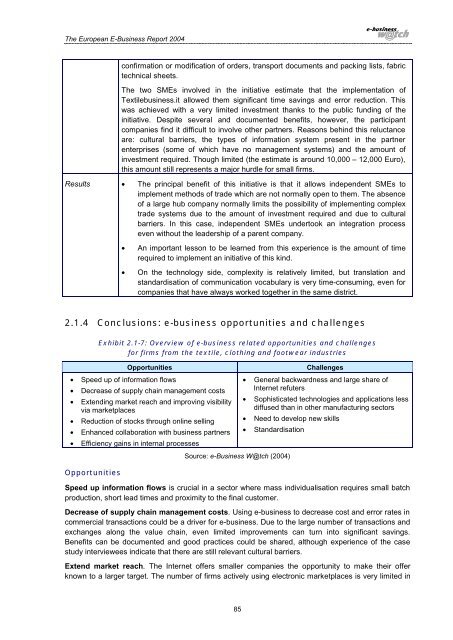The European e-Business Report 2004 - Berlecon Research GmbH
The European e-Business Report 2004 - Berlecon Research GmbH
The European e-Business Report 2004 - Berlecon Research GmbH
You also want an ePaper? Increase the reach of your titles
YUMPU automatically turns print PDFs into web optimized ePapers that Google loves.
<strong>The</strong> <strong>European</strong> E-<strong>Business</strong> <strong>Report</strong> <strong>2004</strong>confirmation or modification of orders, transport documents and packing lists, fabrictechnical sheets.<strong>The</strong> two SMEs involved in the initiative estimate that the implementation ofTextilebusiness.it allowed them significant time savings and error reduction. Thiswas achieved with a very limited investment thanks to the public funding of theinitiative. Despite several and documented benefits, however, the participantcompanies find it difficult to involve other partners. Reasons behind this reluctanceare: cultural barriers, the types of information system present in the partnerenterprises (some of which have no management systems) and the amount ofinvestment required. Though limited (the estimate is around 10,000 – 12,000 Euro),this amount still represents a major hurdle for small firms.Results • <strong>The</strong> principal benefit of this initiative is that it allows independent SMEs toimplement methods of trade which are not normally open to them. <strong>The</strong> absenceof a large hub company normally limits the possibility of implementing complextrade systems due to the amount of investment required and due to culturalbarriers. In this case, independent SMEs undertook an integration processeven without the leadership of a parent company.• An important lesson to be learned from this experience is the amount of timerequired to implement an initiative of this kind.• On the technology side, complexity is relatively limited, but translation andstandardisation of communication vocabulary is very time-consuming, even forcompanies that have always worked together in the same district.2.1.4 Conclusions: e-business opportunities and challengesExhibit 2.1-7: Overview of e-business related opportunities and challengesfor firms from the textile, clothing and footwear industriesOpportunities• Speed up of information flows• Decrease of supply chain management costs• Extending market reach and improving visibilityvia marketplaces• Reduction of stocks through online selling• Enhanced collaboration with business partners• Efficiency gains in internal processesOpportunitiesChallenges• General backwardness and large share ofInternet refuters• Sophisticated technologies and applications lessdiffused than in other manufacturing sectors• Need to develop new skills• StandardisationSource: e-<strong>Business</strong> W@tch (<strong>2004</strong>)Speed up information flows is crucial in a sector where mass individualisation requires small batchproduction, short lead times and proximity to the final customer.Decrease of supply chain management costs. Using e-business to decrease cost and error rates incommercial transactions could be a driver for e-business. Due to the large number of transactions andexchanges along the value chain, even limited improvements can turn into significant savings.Benefits can be documented and good practices could be shared, although experience of the casestudy interviewees indicate that there are still relevant cultural barriers.Extend market reach. <strong>The</strong> Internet offers smaller companies the opportunity to make their offerknown to a larger target. <strong>The</strong> number of firms actively using electronic marketplaces is very limited in85
















